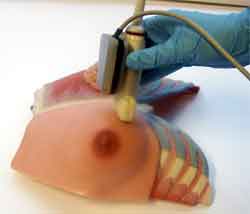3D images of the inside of the body are in great demand for diagnostic purposes. But the equipment required to produce them is extremely expensive.
Thanks to a new development, however, conventional 2D ultrasound scanners can now be inexpensively upgraded to provide 3D images.
In collaboration with the software company MedCom, researchers from the Fraunhofer Technology Development Group TEG and the Fraunhofer Institute for Biomedical Engineering IBMT, have succeeded in producing the considerably less expensive solution for physicians.
The system that enables conventional 2D ultrasound scanners to be upgraded to provide 3D images for as little as 400 Euros.
'To do so, traditional ultrasound transducers are fitted with inertial sensors that can determine the exact position and orientation of the probe,' explained Dr. Urs Schneider, project manager at the TEG. 'Specially developed algorithms then allow us to reconstruct a three-dimensional image from the data thus obtained.'
The inertial sensors are small, inexpensive semiconductor components that are sensitive to movement in any direction. Such sensors are normally very imprecise, especially when determining equatorial coordinates. However, the special algorithms developed by the TEG engineers enable the exact calculation of spatial coordinates.
The margin of error of the sensors has therefore been reduced from around 10 degrees to less than one degree allowing a highly accurate, low-cost navigation system to be integrated into existing ultrasound scanners.

This inexpensive upgrade makes it possible to improve standards of healthcare, particularly in eastern European countries.
Schneider expects the new system, which consists of a small device installed with the necessary software, to be commercially available later this year.




Glasgow trial explores AR cues for autonomous road safety
They've ploughed into a few vulnerable road users in the past. Making that less likely will make it spectacularly easy to stop the traffic for...